Source: Masvingo records increase in veldfires – NewsDay Zimbabwe
BY TATENDA CHITAGU
MASVINGO province last year recorded an increase in veldfires compared to 2020, latest statistics availed by the Environmental Management Agency (Ema) have revealed.In a statement marking the national fire awareness week, Ema said the area destroyed by fire quadrupled from 10 859,23 hectares in 2020 to 46 560,28 hectares last year.
The most affected district was Gutu with a total of 20 219,31 hectares, followed by Masvingo district with 17 598,41 hectares. Bikita district had 3 500,51 hectares burnt, while Mwenezi had 2 619,65 hectares.
Chiredzi district lost 2 018,18 hectares, while Zaka district had 59,125 hectares destroyed by fire. Chivi district had 12,97 hectares destroyed. Two people died due to fire in the province.
“The major cause of the veldfires was land preparation using fire. The other causes recorded were suspected poaching/hunting, tick disease control, arson, electricity powerline failure, burning of waste, charcoal making, bee smoking and fires left unattended,” Ema Masvingo province said in the statement.
To minimise veldfire incidences and related offences in the province during the 2021 fire season, Ema issued 119 fireguard construction orders to farmers and plot holders, a total of 40 tickets and three dockets were opened for veldfire-related offences.
At national level, eight lives were lost due to veldfires, while there was a reduction of hectarage destroyed by fire. The country record a total of 1 033 722,86 hectares of forest and grassland destroyed in 2021, compared to 1 100 000 hectares in 2020.
The National Veld Fire Awareness Week is commemorated during the second week of May each year.
This year’s theme is Veld Fires, a Food Security threat — Protect the Harvest.
Zimbabwe will launch the fire season from July 31 to October 31 to encourage people not to start fires outside their residential and commercial properties.
“If we do not put enough effort to prevent veldfires, we risk losing the hard-earned drought impacted crop yields and animal forage, derailing all our efforts at attaining an upper middle class economy we aim for in 2030.
“The rainfall experienced in the province and country at large has resulted in excessive fuel load build-up (grass biomass production) in most parts of the province increasing the risk of veldfires in the year 2022. As Ema we, therefore, urge the communities to put in place pre-veldfire suppression measures like fireguards, undertake hay baling, thatch grass harvesting and have readily functional and well-equipped firefighting teams. We also appeal to various stakeholders like the Transport and Infrastructural Development ministry to clear road servitudes of all biomass; The Zimbabwe Electricity Transmission and Distribution Company and telecommunication companies to do likewise to ensure safety of their infrastructure such as powerlines, transformers and boosters,” Ema said.

